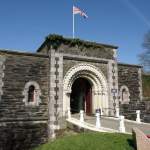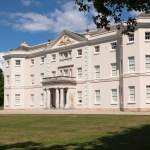This fine medieval house near Yelverton was once (as the name suggests) an abbey. Originally settled by Cistercian monks, the abbey and its estate were founded in 1278. However, as with virtually all of England's abbeys, Buckland was forced to close in the 1540s by Henry VIII and his Dissolution of the Monasteries. Fortunately Buckland Abbey did not suffer the fate of many of these fine buildings and has managed to survive to this day.
After the monks the first owner of Buckland was a Sir Richard Grenville, the former Marshall of Calais. He bought it with the intention of converting the abbey into a country house for his son Roger. However, Roger was aboard Henry VIII's ill-fated Mary Rose when it sank of Portsmouth.
Instead the estate passed on to Sir Richard's grandson, another Richard. It was he who carried out the conversion of the abbey church into a home retaining the original church tower and dividing the nave into three floors. Many of the somewhat flamboyant touches within the house, such as the plasterwork and wood carvings, were also down to Richard who was said to have had quite eccentric taste.
In 1582 the house was sold on, to an unknown buyer who used an agent to make the purchase. This turned out to be Sir Francis Drake, Sir Richard's greatest rival whom he despised. Drake had become incredibly wealthy following his discoveries in the New World and circumnavigating the globe and Buckland Abbey was just one of many properties he bought in his native Devon. Drake owned Buckland Abbey for 15 years, until his death, and apparently made very few changes.
In that time he managed to incur the suspicion of the locals, some of whom believed him to be in league with the devil. The legend is that as punishment for his satanic dalliances Drake's ghost was condemned to ride in a hearse, pulled by headless horses, across Dartmoor on wild nights with a pack of demonic hounds following.
Another ghostly story concerning Drake and the abbey is that of Drake's Drum. It is said that the soul of Drake is contained within the drum that is on display in the abbey. The story goes that Drake gave instructions for the drum to be returned to his home as he lay dying on his ship, the Puerto Bello in 1596. Legend states that if ever England is in danger then the drum will be heard to beat. The last time it was heard was in 1939...
Whilst Drake did little to modify Buckland some additions were made in more recent times. Some of the windows of the chapel contain stained glass which was rescued from Reims Cathedral in France after World War I and in 1988 further stained glass were commissioned for the stairwell to commemorate the 400th anniversary of the defeat of the Spanish Armada.
The house was donated to the National Trust in 1948 by one of Drake's descendants and is now open to the public. As well as the abbey itself there are the gardens and wider estate to explore. Trails lead through woodlands and meadows with unspoilt views over the Tavy Valley beyond. More formal gardens surround the house such as the Elizabethan Garden along with the orchards and herbaceous borders that surround the Cider House. There is also a secret ‘wild’ garden which is ideal for a bit of peaceful contemplation - or a game of hide and seek.




